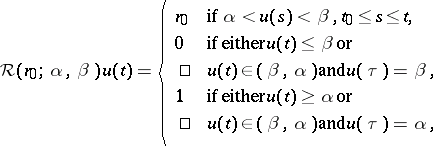Non-ideal relay
The hysteresis non-linearity denoted by  , with thresholds
, with thresholds  and
and  , and defined for a continuous input
, and defined for a continuous input  ,
,  , and an initial state
, and an initial state  by the formulas (see Fig.a1.)
by the formulas (see Fig.a1.)
 |
where  , that is,
, that is,  denotes the last switching moment. The input–output operators
denotes the last switching moment. The input–output operators  are discontinuous in the usual function spaces. These operators are monotone in a natural sense, which allows one to use the powerful methods of the theory of semi-ordered spaces in the analysis of systems with non-ideal relays.
are discontinuous in the usual function spaces. These operators are monotone in a natural sense, which allows one to use the powerful methods of the theory of semi-ordered spaces in the analysis of systems with non-ideal relays.

Figure: n110060a
Non-ideal relay
The Preisach–Giltay model of ferromagnetic hysteresis is described as the spectral decomposition in a continual system of non-ideal relays in the following way. Let  be a finite Borel measure in the half-plane
be a finite Borel measure in the half-plane  . The input–output operators of the Preisach–Giltay hysteresis non-linearity at a given continuous input
. The input–output operators of the Preisach–Giltay hysteresis non-linearity at a given continuous input  ,
,  , and initial state
, and initial state  is defined by the formula
is defined by the formula
 |
where the measurable function  describes the internal state of the non-linearity at the initial moment
describes the internal state of the non-linearity at the initial moment  . In contrast to the individual non-ideal relay, the operators of a Preisach–Giltay non-linearity are continuous in the space of continuous functions, provided that the measure
. In contrast to the individual non-ideal relay, the operators of a Preisach–Giltay non-linearity are continuous in the space of continuous functions, provided that the measure  is absolutely continuous with respect to the Lebesgue measure (cf. Absolute continuity). For detailed properties of Preisach–Giltay hysteresis and further generalizations see [a1], [a2] and the references therein.
is absolutely continuous with respect to the Lebesgue measure (cf. Absolute continuity). For detailed properties of Preisach–Giltay hysteresis and further generalizations see [a1], [a2] and the references therein.
See also Hysteresis.
References
| [a1] | M.A. Krasnosel'skii, A.V. Pokrovskii, "Systems with hysteresis" , Springer (1989) (In Russian) |
| [a2] | I.D. Mayergoyz, "Mathematical models of hysteresis" , Springer (1991) |
Non-ideal relay. Encyclopedia of Mathematics. URL: http://encyclopediaofmath.org/index.php?title=Non-ideal_relay&oldid=13966